| COLOR MATCHING IN ART REPRODUCTION
|
 |
| Once an artwork scan has created a digital image of the original piece, the work of the print technician has only just begun. Perhaps the most important step between Original and Print is the color matching process. This process ensures the printed copy on paper or canvas will look as much like the original painting as possible.
There are numerous factors involved in color matching, affected not only by the digital image, but by the printer, the paper or canvas, the ink - even temperature and humidity can alter the outcome.
Take a look at the table summary below, then read on to learn about color matching fine art prints.
|
| SUMMARY |
TO ACHIEVE A COLOR MATCH |
| CAMERA |
Studio lighting, and a high-quality dSLR camera intended for art reproduction, will create the best digital copy possible. |
| SCANNER |
Light must not enter between the scanner bed and the artwork; conditions must be maintained if multiple images are required, in the case of a large artwork. Cruse and Epson scanners are often used in professional print shops. |
| MONITOR |
Correct color calibration; RGB color mode should be used to best represent the image on screen. |
| SUBSTRATE |
Every substrate (surface) that is printed requires a different color profile. If multiple types of papers are used - a fine art paper and a photographic paper, for instance - multiple profiles must be used as well. |
| INKS |
The color profile will take into consideration the printer model, and therefore the number and type of inks used. Ink cannot always perfectly match a color created by blending paints. |
TEMPERATURE/
HUMIDITY |
Low temperatures can cause pigment inks to thicken, hindering their ability to drip from the print head. Humidity can change the absorbency of the paper, rendering the color profile incorrect. |
| WHAT IS COLOR MATCHING? |
 |
|
Color matching is a process used print technicians to ensure the printed reproduction of an artwork matches the original piece as closely as possible. Unfortunately, it is extremely unlikely that a 100% match will be achieved. Limitations of the printer and scanner (outlined in more detail below) mean the exact color created by blending paints cannot always be mimicked by ink. Additionally, it is the eye that ultimately compares the reproduction and the original; some eyes will see colors differently, some will pick up more tonal differences than others. That said, the print technician will do everything in their power to create a print that is virtually indistinguishable from the original.
Color matching is not simply a matter of fiddling with dials on Photoshop until the image on the computer screen looks like the physical artwork sitting next to it. Numerous factors involved in color correction (outlined briefly above) must be taken into consideration before the print technician will be satisfied enough to print the digital image.
Even at that point, most printers will produce a hard proof - a section of the print, on the paper or canvas that will be used for the full print, at the size that section will be printed - for comparison. For each new substrate (surface) onto which ink is laid to create a print, a new color match must be done. Common substrates for fine art reproduction include canvas, fine art paper, photographic paper, wood and fabric.
For the final product to be the best possible reproduction, care and consideration must be taken at every step of the process. The artist or owner of the original artwork should be willing to leave their work in the hands of the print technician for a number of days, as having this piece available for comparison is essential.
One of the most important terms to understand when it comes to color matching is "Color Gamut". Every printer, substrate (paper, canvas, etc), and computer monitor has a different color gamut, or range of colors, it can accurately reproduce. Practically speaking, this means that a color seen on the computer monitor may be impossible to recreate with the printer. In such cases, the printer's software is designed to recognize this inability and swap this color for the closest shade it can create. Color gamuts are a primary consideration when creating a color profile.
The human eye has a wider color gamut (ie: can see more colors) than any digital device. Generally speaking, computer monitors have a wider color gamut than printers, though there are still some colors a printer can reproduce that a monitor cannot, and of course vice versa. To further complicate matters, each different substrate - fine art paper, photographic paper, canvas - is limited in the colors it can accurately display. Canvas often has a low color gamut and has difficulty distinguishing between similar dark shades, so a darker image would appear mostly black or gray, and lack the desired gradients.
ICC Color Profiles
Any time an image is being transferred from one view to another - camera/scanner to computer monitor, computer monitor to printed image - the color profile for that particular device/substrate must be used to ensure the colors are correctly reproduced in the new view.
ICC stands for International Color Consortium. The organization certifies color profiles so they can be widely recognized and utilized by different programs (since each program has its own Color Management System). Color profiles are made up of tables of data that help the computer correctly display the colors in the transferred image, and are created by the company who manufactured the device. The profile tells the print technician the lightest and darkest tones in the image file and the color range (gamut), as well as the relationship between the color tones. In addition, a color profile can describe the abilities of the monitor, camera, scanner, printer, or substrate.
The customer may require the color profile from the print technician if they would like to see a soft proof - a digital view of their image once the color match is done but before it has been printed. A soft proof will only be useful if the customer's monitor is correctly calibrated. Unfortunately, KeenART Media is unable to provide ICC profiles for soft proofs.
|
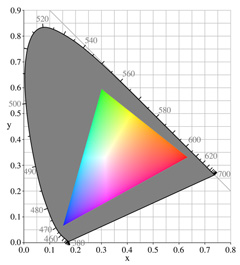
A color gamut within the full color range
|
| THE IMAGE CREATOR: CAMERA OR SCANNER |
 |
|
It should come as no surprise that in order for the printed reproduction to accurately mimic the original, the digital image needs to be pretty close already.
Computer software can do wonders to an image - straighten an edge curved by lens distortion, or erase a rip in the canvas - but if the photograph was taken in low light with a flash, or the scan allowed light between the scanner bed and the artwork, there isn't much the software can do. Unless you own professional fine art scanning or photography equipment, take your artwork to a professional.
-
A photographer practised in art reproduction will have the necessary lighting to ensure no unwanted tints or gray washes will mar the image, and will know how to set his or her camera (usually one specifically designed for the purpose) to the correct color profile.
-
A fine art printing company will have a high-quality scanner that will ensure the original lies flat for even scanning, is protected, and if multiple scans are necessary for a large piece, that each image is taken under the same conditions for easy reconstruction afterwards.
|
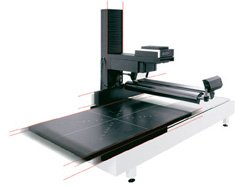
A Cruse brand fine art scanner
|
| THE MONITOR |
 |
|
The image recorded by the scanner or camera could be spot on, but if the computer monitor is not color calibrated correctly, all that previous attention to detail was for naught. Any print technician who produces fine art reproductions will have a correctly calibrated monitor, which should show them roughly what the inkjet printer will produce. Any changes they make to the digital image will be echoed by the printer.
It is important to remember that a computer is not a human eye, and therefore, no matter how good the digital image may be, some alterations are most likely needed. The computer may interpret certain colors differently than the eye.
For printing art reproductions, it is generally agreed that the RGB color mode (or color space) produces the best digital reproduction (what you see on your screen), even though printers print in CMYK color mode. Color mode is essentially a language that describes the primary color values within the image, and each mode has its own color gamut. This mode can be changed in the image editing software, or set on the camera or scanner prior to recording the image. Unfortunately, all devices interpret "RGB Mode" differently, based on their gamut. That is why a color profile is vital.
The print technician will skillfully maneuver the RGB colors, brightness, shadows and highlight levels within the image editing software, making sure the computer (and therefore the printer) sees the colors of the digital image the same way the eye sees the colors of the original. The editor can also be used to remove or correct any part of the original that the artist or owner would like to change.
|
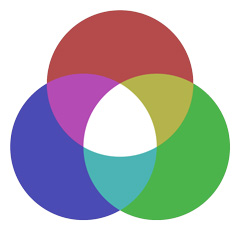
RBG are digital primary colors
|
| THE PRINTER |
 |
|
When it comes to the printer itself, there are a number of factors that may affect the final print.
PAPER
Color calibration does not just apply to the interaction between the image, computer, and printer. Every time a new substrate (fine art paper, photography paper, canvas, etc.) is inserted into the printer, a different color profile must be used. The color profile tells the printer how to make the print match the image on the screen. The absorbency, color, texture and thickness of the substrate can drastically affect the printed image.
For this reason, it is important the customer choose their paper or canvas early, and does not change their mind once a color match is achieved - if they do, a whole new profile must be used.
INKS
The color profile is available for each brand and model of printer. Depending on the model, the printer may use 4, 5 or even 10 different colors or shades, mixed together to create the hues you see on the printed image, and the color profile will reflect this.
Inkjet printers (used for creating Giclée prints, as opposed to laser printers) use pigment inks which consist of powdered color mixed with a liquid binder. Pigment inks provide stable color that should not change from print to print, and should not fade over time if properly displayed.
TEMPERATURE AND HUMIDITY
The viscosity, or thickness, of pigment ink increase as the temperature falls. If the temperature is too low, the ink may not drip from the printer head at the correct speed. This will therefore affect the color density of that droplet - it may not be as bold or as opaque as it is supposed to be, or it may be too much so. If the printer experiences fluctuations in temperature, multiple copies of the same image - or even different sections of one copy - could end up looking quite different.
Likewise, humidity can affect the color of the print. The properties of the ink may change and drying time may slow, making smudging and therefore mixing of the colors more likely. Humidity also affects the absorbency or moisture level of the paper. If multiple copies of one image are made on paper with different moisture levels, different absorption rates will cause the colors to vary from print to print.
|
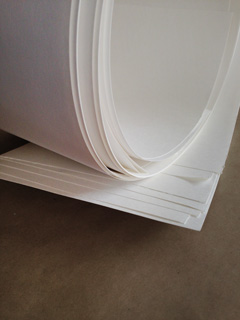
Each paper has a different color profile
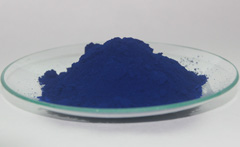
Powdered pigment mixed with water is used in inkjet printers
|
| CONSISTANCY: LIMITED EDITIONS |
 |
|
All the factors mentioned above must be considered, and uniform conditions maintained, any time a customer requires multiple copies of the same image. In the case of limited editions (a specified number of copies of one art print, after which time no more copies are produced), color matching and uniformity from print to print is essential; collectors are generally paying good money to receive a limited edition print that is identical to the original and to the other prints.
Since the original has likely been returned to the artist, the print technician must be confident that their color profile is still correct for that image should another run be ordered weeks or even months later. The inks, paper and printer must be maintained in excellent condition, as they were during the previous run, to ensure all print conditions are the same.
|
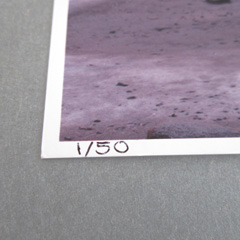
A numbered, limited edition print.
|
| Color matching a digital print to an original artwork is a time consuming and detail-oriented task. This is why it is very important that the customer know what they require prior to placing their order. Even when all conditions are perfect, it is highly unlikely that a printed image will be an exact match to the original. Every single color the artist used cannot be perfectly matched, so the print technician may encourage the customer to choose the most important part of the image (a figure's skin tone, for example), and ensure that section is exactly right (as well as other parts of the image where those colors appear). The complete print should be a 90% match to the original, and may require multiple hard proofs: a lot of trial-and-error.
The scanning process, including pre-press manipulation and color matching, generally costs between $75 and $200, with additional charges for additional services or proofs.
At KeenART Media, we offer a 300 DPI scans (the minimum resolution for a Giclée print) starting at $35 for an 8x10" artwork. Optional 8x10" hard proofs on the chosen substrate cost $20 each for up to three altered proofs. If the customer is still not satisfied with the color match, or decides on a different substrate, additional proofs are available for $15 each. We use Cruse and Epson artwork scanners and top quality Epson Giclée printers to create your fine art reproduction.
|
|

|



|
USA Giclee On Canvas, Fine Art Printing - Art Scanning & Reproductions - Handmade Oil Paintings - Custom Wood Panels, Metal Picture Framing - Block/Plaque Mountings, Large Format Dry Mounting & Lamination - Art Supplies: Stretcher Bars, Cradled Wood Panels and Artist Canvas - Collages On Canvas - Plexi/Acrylic Face Mounts - Block Acrylics, Fabric Printing, Dye Sublimation - Cityscape Skyline Prints, Resin, Photo Gifts and more...
Frame Assembly Guide - Dovetail System
USA Laser Engraving & Cutting Services
|
|
© 2002-2024 - KeenART Media Ltd.
|
|
| |
|
